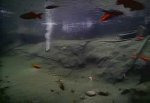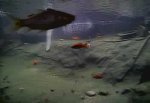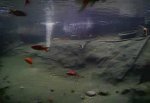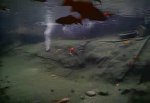But I said farmers use it so farmers must use it. And therefore it must work because they use it. How much more proof could anyone ever ask?
String Algae
- Thread starter Sally
- Start date
callingcolleen1
mad hatter
- Joined
- May 1, 2012
- Messages
- 9,432
- Reaction score
- 8,130
- Hardiness Zone
- 4a
- Country

Its OK WB to dislike barley, I dislike some things too. But what I like about the barley is that it's not harmful to fish and the floating barley baskets sound like a real good idea for plants. Barley does dye the water a nice golden color too when used in large concentrations, and I like that too.  (-: :-o.
(-: :-o.
:>) ... (+8 ... B-) how many funny faces can you make?
:>) ... (+8 ... B-) how many funny faces can you make?
- Joined
- Jun 23, 2010
- Messages
- 45,146
- Reaction score
- 30,225
- Location
- Frederick, Maryland
- Showcase(s):
- 1
- Hardiness Zone
- 6b
- Country

There are neat barley plant pots, I had them in my arizona pond, the plants loved to grow in them
I have only seen coconut plant inserts. Are the barley plant pots readily available? :question: They sound like something that would work...if not too expensive. 
:goldfish:
:goldfish:
callingcolleen1
mad hatter
- Joined
- May 1, 2012
- Messages
- 9,432
- Reaction score
- 8,130
- Hardiness Zone
- 4a
- Country

Hey Shoestring, nice puppy, was thinking of making some kind of coconut planter with these coconut pots I had left over from spring, but need to make it float, will look for floating ring at second hand store to put it in. 
I don't like or dislike barley. Barley has never keyed my car.Its OK WB to dislike barley, I dislike some things too.
I don't even dislike people who choose not to use logic and instead believe in magic and myth. They don't really have any impact on my life. Listening to their "facts" is always entertaining, at least to a point. Get's kind of boring pretty fast. I adore new "ideas" like uses for caterpillar poop. Epic. I genuinely wish more people had such interesting concepts.
Posting information about a subject doesn't mean I dislike or like something. But I can understand why a person who puts great stock in magic and myth would view information emotionally. When "facts" come from the a person's gut there's a lot of ownership. When I repeat information I've read I don't really have any ownership or attachment. If someone can show there's better info I'll just switch to using the better info.
You may find this unbelievable but some people think rotting organic matter is harmful to fish as is the DOCs which produce that lovely golden color. In an upside down, who cares about facts, world a person could even say barley balances a pond.But what I like about the barley is that it's not harmful to fish and the floating barley baskets sound like a real good idea for plants. Barley does dye the water a nice golden color too when used in large concentrations, and I like that too.
callingcolleen1
mad hatter
- Joined
- May 1, 2012
- Messages
- 9,432
- Reaction score
- 8,130
- Hardiness Zone
- 4a
- Country

WB' I can see that your very smart, although I study things differently and see things in a "different light" than most people and that is good, cause we can't all live in the "same box" or we will become stagnment and not learn new and exciting things.
Caterpillers are just wonderful, and their dung is amazing to see and study the effects it has on my pond. Dead and decaying leaf litter does not always equate to bad. If your pond is balanced with the proper aquatic bugs, bacteria, plants and good filteration, your pond will simply eat it and absorb the excess waste.
In a real life pond, no one cleans it, no one filters it, water trickles from various sources and replenishes the pond. I have seen ponds such as this here around Medicine Hat, some are not even as big as you think, and yet there is life, abundant life in and around the pond. There are lots of trees, lots of waste, no filter, no UV light, but somehow life lives there, and quite good, the water is clear, their are fish, snails, leeches and other various types of aquatic life that thrive in a natural pond setting.
Here in the real world my pond is much smaller, but I have accomplished much the same on a smaller scale. I have filters and good water circulation that real pond might not have, but a real pond has a large volume of water. I have alot of the same aquatic life, large plant marshes, some of which naturally float like my yellow flag iris, and lots of bugs and leeches. leeches play a vital role in pond life, they take care of the dead and dying. For example, if you have ever had a large apple snail that died, and you did not find it, the waste could polute the pond and kill fish. But if your pond is balanced with all types of aquatic life, including leeches, the leeches would take care of the dead and dying apple snail before it could become toxic. The cleanest lakes in Canada are filled with leeches.
My pond is quite balanced now, after many years, and it takes care of its self quite nicely. I just clean the filters, and net out excess sludge from the area that gets the most, the bottom Pond, and this is only as needed, not too frequently or it will disturb the pond life too much. I never change the water, except a couple years ago I tore apart the bottom pond and make it larger. But because I have three ponds that flow together, it was not catastrophic in nature. I was able to drag the very large marches back into place in the very early spring and everything recovered quite nicely. This level of success can take a couple years to achieve for some, and requires wintering the pond in a suitable manner for your area.
If you take your pond apart and clean to death and restart each year, you will most likely not reach this level of success, unless you have large marshes that come back to life each year. Large marshes are one of the main keys elements to having a successful pond. The marsh will eventually have many types of different aquatic life that will sustain a pond for life. You don't have to have fancy marches, you can just take a shallow end of the pond and rock it off and let plants loose, as some will eventually bust out of their small containers and root freely throughout the pond, These plants should be wintered to your zone so that you will always have a reliable marsh that grows early in the spring, to get you though the long hot summer.
Caterpillers are just wonderful, and their dung is amazing to see and study the effects it has on my pond. Dead and decaying leaf litter does not always equate to bad. If your pond is balanced with the proper aquatic bugs, bacteria, plants and good filteration, your pond will simply eat it and absorb the excess waste.
In a real life pond, no one cleans it, no one filters it, water trickles from various sources and replenishes the pond. I have seen ponds such as this here around Medicine Hat, some are not even as big as you think, and yet there is life, abundant life in and around the pond. There are lots of trees, lots of waste, no filter, no UV light, but somehow life lives there, and quite good, the water is clear, their are fish, snails, leeches and other various types of aquatic life that thrive in a natural pond setting.
Here in the real world my pond is much smaller, but I have accomplished much the same on a smaller scale. I have filters and good water circulation that real pond might not have, but a real pond has a large volume of water. I have alot of the same aquatic life, large plant marshes, some of which naturally float like my yellow flag iris, and lots of bugs and leeches. leeches play a vital role in pond life, they take care of the dead and dying. For example, if you have ever had a large apple snail that died, and you did not find it, the waste could polute the pond and kill fish. But if your pond is balanced with all types of aquatic life, including leeches, the leeches would take care of the dead and dying apple snail before it could become toxic. The cleanest lakes in Canada are filled with leeches.
My pond is quite balanced now, after many years, and it takes care of its self quite nicely. I just clean the filters, and net out excess sludge from the area that gets the most, the bottom Pond, and this is only as needed, not too frequently or it will disturb the pond life too much. I never change the water, except a couple years ago I tore apart the bottom pond and make it larger. But because I have three ponds that flow together, it was not catastrophic in nature. I was able to drag the very large marches back into place in the very early spring and everything recovered quite nicely. This level of success can take a couple years to achieve for some, and requires wintering the pond in a suitable manner for your area.
If you take your pond apart and clean to death and restart each year, you will most likely not reach this level of success, unless you have large marshes that come back to life each year. Large marshes are one of the main keys elements to having a successful pond. The marsh will eventually have many types of different aquatic life that will sustain a pond for life. You don't have to have fancy marches, you can just take a shallow end of the pond and rock it off and let plants loose, as some will eventually bust out of their small containers and root freely throughout the pond, These plants should be wintered to your zone so that you will always have a reliable marsh that grows early in the spring, to get you though the long hot summer.
- Joined
- Jun 23, 2010
- Messages
- 45,146
- Reaction score
- 30,225
- Location
- Frederick, Maryland
- Showcase(s):
- 1
- Hardiness Zone
- 6b
- Country

We all use different methods. I have used the floating barley balls, they made neat planters.
A lot of pond people trashed my bog filter when I was working on it, it works great. I was told I needed "real" filtration.
Your method above works for you.
Skippies work for others.
Large koi type filter setups for others, trickle towers for others.
The same box for all ponds is not a reality.
A lot of pond people trashed my bog filter when I was working on it, it works great. I was told I needed "real" filtration.
Your method above works for you.
Skippies work for others.
Large koi type filter setups for others, trickle towers for others.
The same box for all ponds is not a reality.
callingcolleen1
mad hatter
- Joined
- May 1, 2012
- Messages
- 9,432
- Reaction score
- 8,130
- Hardiness Zone
- 4a
- Country

addy: I don't even know what a skippy filter is. My filters are simple and cheap and some are 20 years old and I still use them. I have filters before the pumps, and I just have smaller pumps but several of them, that way in the winter if one dies, the others are still working, and all is still well.
If I every get round to it, I would like to have a gravel filter marsh like yours to let my rush loose so it can grow bigger. I think your gravel bog filter is the cats meow, (awesome) and everyone should try to have one. The gravel is a filter and the plants are a filter too, combine the two and you have a very powerful filter that looks just wonderfully natural!
If I every get round to it, I would like to have a gravel filter marsh like yours to let my rush loose so it can grow bigger. I think your gravel bog filter is the cats meow, (awesome) and everyone should try to have one. The gravel is a filter and the plants are a filter too, combine the two and you have a very powerful filter that looks just wonderfully natural!
- Joined
- Jun 23, 2010
- Messages
- 45,146
- Reaction score
- 30,225
- Location
- Frederick, Maryland
- Showcase(s):
- 1
- Hardiness Zone
- 6b
- Country

callingcolleen1
mad hatter
- Joined
- May 1, 2012
- Messages
- 9,432
- Reaction score
- 8,130
- Hardiness Zone
- 4a
- Country

Nice! Did you get up early and have coffee by the pond?
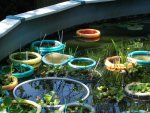
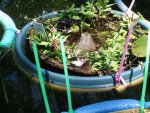
 Madhatter,
Madhatter,Thanks for the compliment on my boy, Baxter. He is quite the snuggler and last night, I woke up to 42* here this morning, he snuggled right in. :heartpump: At any rate, I use pool noodles that you can purchase from the $Tree. I buy the "flower type" ones rather than the smooth ones. I then slice through the grooves to make either 2 bump floate, 3 bump floats or at times, 1 bump floats. The 3 bump floats are for very heavy things I want to float. The $Tree is my friend along with Deal$. Do you have them in Canada? I would send you a pool noodle, but by the time it got through customs, cross the border, it would be close to winter!
The big guy is Rusty...he misses his pool and has decided the new kiddy pool is not the same for swimming in as the one that is now a pond! :sad: Poor guy, he looks so underappreciated and under loved! :heartpump:  I should really put this under DIY, but these floats also lend themselves to the subject at hand....algae and shade for the fish. We had an extremely hot April and my pond is green. I do not have the means to purchase a UV system and I want this pond to be a natural as can be. I float these plants to help suck up the nutrients that are causing the algae bloom in addition to providing shade for my fish until the hyacinth multiply enough to help w the water. I have a couple of floating planters that I put in one of those solar lights and at night it is really pretty. I know my pond does not measure up to the beautiful ones most ponders have, but circumstances necessitated this conversion. I also feel this end of the pond spectrum gives others ideas, shoestring ideas at that. My fish are doing well and the Bullfrog and Green Frog seem to be happy. I have waterbugs, swimmers and some snails as well as floating barley bails working on the algae. With it being a bit chilly this morning, I also have fish spawning and I am sure the temps of the water are warmer than the air, but they should be going down as well w it being 42* here this morning. :goldfish:
I should really put this under DIY, but these floats also lend themselves to the subject at hand....algae and shade for the fish. We had an extremely hot April and my pond is green. I do not have the means to purchase a UV system and I want this pond to be a natural as can be. I float these plants to help suck up the nutrients that are causing the algae bloom in addition to providing shade for my fish until the hyacinth multiply enough to help w the water. I have a couple of floating planters that I put in one of those solar lights and at night it is really pretty. I know my pond does not measure up to the beautiful ones most ponders have, but circumstances necessitated this conversion. I also feel this end of the pond spectrum gives others ideas, shoestring ideas at that. My fish are doing well and the Bullfrog and Green Frog seem to be happy. I have waterbugs, swimmers and some snails as well as floating barley bails working on the algae. With it being a bit chilly this morning, I also have fish spawning and I am sure the temps of the water are warmer than the air, but they should be going down as well w it being 42* here this morning. :goldfish:
j.w
I Love my Goldies
- Joined
- Feb 1, 2010
- Messages
- 34,124
- Reaction score
- 21,012
- Location
- Arlington, Washington
- Showcase(s):
- 1
- Hardiness Zone
- USDA 8a
- Country

Clever ideas SP! Sorry Rusty lost his swimming hole.............maybe you could dig him his own pond and put in a heavy duty liner or cement bottom w/ a drain 
JohnHuff
I know nothing.
- Joined
- Apr 17, 2012
- Messages
- 2,257
- Reaction score
- 1,621
- Location
- At my computer
- Hardiness Zone
- 1a
- Country

OMG, that little guy is so cute 





Ask a Question
Want to reply to this thread or ask your own question?
You'll need to choose a username for the site, which only take a couple of moments. After that, you can post your question and our members will help you out.
Forum statistics
Latest Threads
-
Protecting small pond from Herring Gulls
- Started by hiacedrifter
-
New Pond Help/Aeration
- Started by whittwhitt
-
Not really aquatic, but was doing portraits today
- Started by chibae
-
Owl season again
- Started by Hound Heaven
-
This place has done wonders for my soul, better than chicken soup
- Started by chibae
-
Cleanout pipe in the bog
- Started by sherry
-
Red Squirrel at the stream
- Started by RobAmy
-
New here from northern Utah, USA
- Started by bluefrog
-
DIY pump vault?
- Started by bluefrog
-
Lotus essentials
- Started by Hound Heaven

